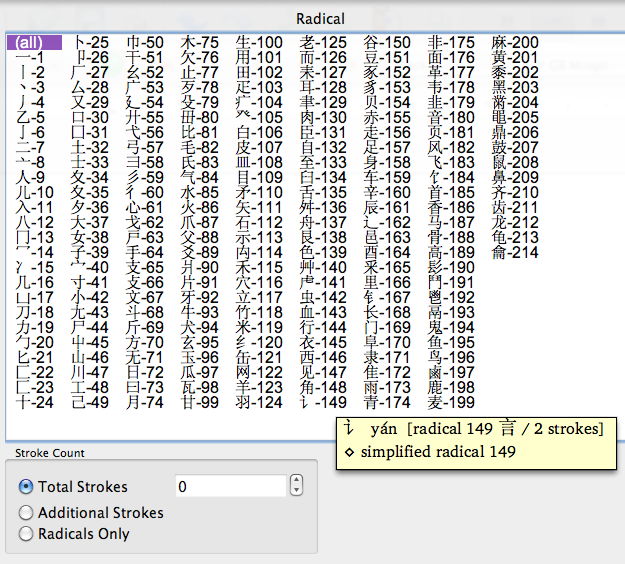The MandarWeb Website: The older "radical" base system page
Section 10. The older "radical" base system
Before Pinyin was available, Chinese dictionaries (or the Chinese-English sections of a bilingual dictionary) were organized by their "radical", the "root" of a given character. There are 214 of these radicals in use for Mandarin, and they can be referred to by their number, for example "radical 67".

The 214 Mandarin radicals (derived from MacKEY5, [11])
At first sight, these radicals look similar to the Codels you downloaded from Z1CodelGrid.pdf and Z2CodelGrid.pdf, but there are fundamental differences in their use.
To identify a character using radicals, you need first to look at it and work out what its radical is. Then you count the number of strokes you need to add to the radical to make it look like the character you have. You can then look it up in a radical-based dictionary under the radical number, and within that the number of additional strokes needed.
It sounds simple, but in practice there are many difficulties. Some of these are as follows.
1. You cannot always easily determine which part of the character is the radical -- some characters obviously contain two or more parts which look like radicals. For example,  (yu4, meaning "inform") contains Radical 149 on the left, Radical 30 or 31 at bottom right, and at top right a part which exists as a separate character 五 (wu3, "five"), which in the radical system is Radical 7 plus 4 strokes.
(yu4, meaning "inform") contains Radical 149 on the left, Radical 30 or 31 at bottom right, and at top right a part which exists as a separate character 五 (wu3, "five"), which in the radical system is Radical 7 plus 4 strokes.
2. Some of the radicals look extremely similar, 30 and 31, 34 and 35, or 4 and 6, for example.
3. When combined in a character, some radicals change their shape dramatically. Radical 140 looks like  . In combination, it changes to a simple bar with two lines through it, as in the top part of
. In combination, it changes to a simple bar with two lines through it, as in the top part of  .
.
4. The way "strokes" in a character are counted is not always what you might expect. Radicals 30 and 31, which both look like square boxes, are each considered to be made up of 3 strokes, not 4.
Different needs of Chinese and foreign readers
Some of the above problems may be due to inevitable changes occurring in the usage of a system dating back over 2000 years, while others stem from the character simplification process by the Chinese government in the 1950s.
The Codel character identification system explained on this MandarWeb website is a new system which attempts to overcome most of the above problems. There is an important point, that it is intended for people for whom Chinese is not their native language.
When young Chinese children enter school, they can usually speak the language, but not write it. The Pinyin system and its use in teaching, dictionaries, and smartphones has been of great help for them.
For non-Chinese wanting to learn to read Chinese characters, the position is totally different. They cannot work from pronunciation, because they may not know it. They could, however, use the old radical system, and they can now use MandarWeb, to derive the character from its appearance.
In practice, Chinese children learn the characters bit by bit, like English children learning the alphabet. Foreigners can do the same, progressively learning common Chinese characters in a structured course, or by using "flash cards" [10].
MandarWeb and Radicals are useful as knowledge increases beyond the basics. This web page encourages the analysis of parts of a character, to distinguish between similar characters, aid memory, and sometimes provide a bit of background to meanings.
For a native English speaker, the position is a bit like the use of grammar in a foreign language. Young English children know nothing of grammar. When they want to know more about the English language, or a foreign language such as French, grammar gives them a set of rules to help their learning.
Return to the MandarWeb Home Page
(previous version 1.04, on Web 2008 Oct 22, see http://www.aoi.com.au/mandarin/ ).
Version 2.01, 2015 Mar 13.



 (yu4, meaning "inform") contains Radical 149 on the left, Radical 30 or 31 at bottom right, and at top right a part which exists as a separate character 五 (wu3, "five"), which in the radical system is Radical 7 plus 4 strokes.
(yu4, meaning "inform") contains Radical 149 on the left, Radical 30 or 31 at bottom right, and at top right a part which exists as a separate character 五 (wu3, "five"), which in the radical system is Radical 7 plus 4 strokes.
 . In combination, it changes to a simple bar with two lines through it, as in the top part of
. In combination, it changes to a simple bar with two lines through it, as in the top part of  .
.